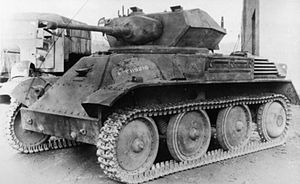| Tank, Light, Mk VIII, Harry Hopkins (A25) | |
|---|---|
 Mk VIII light tank 'Harry Hopkins' | |
| Type | Light tank |
| Place of origin | United Kingdom |
| Production history | |
| Designer | Vickers-Armstrong |
| Manufacturer | Metro-Cammell |
| Produced | 1943–1945 |
| No. built | 100 [1] |
| Variants | Alecto (SPG) |
| Specifications | |
| Mass | 19,040 pounds (8.64 t) |
| Length | 4.34 m (14 ft 3 in) |
| Width | 2.69 m (8 ft 10 in) |
| Height | 2.11 m (6 ft 11 in) |
| Crew | 3 (commander, driver, gunner) |
| Armour | 17–38 mm (0.67–1.50 in) |
Main armament | Ordnance QF 2 pounder 50 rounds |
Secondary armament | 7.92 mm Besa machine gun 2,025 rounds |
| Engine | 149-hp Meadows 12 cyl. petrol engine 148 hp (110 kW) |
| Power/weight | 17.4 hp/tonne |
| Suspension | Steerable road wheels |
Operational range | 125 miles (201 km) |
| Maximum speed | 30 miles per hour (48 km/h) |
The light tank Mk VIII (A25), also known as the Harry Hopkins, after American President Roosevelt's chief diplomatic advisor, and A25 from its General staff specification number, was a British light tank produced by Vickers-Armstrong during the Second World War. The Mk VIII was the last in the line of light tanks the company had built for the British Army, and was intended to be the successor of the previous light tank designed by Vickers-Armstrong, the Mk VII Tetrarch. A number of changes were made to the Mk VIII, most notably increasing its width, length and weight and also increasing the thickness of the armour. The design of the tank was submitted to the War Office in late 1941, with an initial order for 1,000 models being made by the Tank Board of the War Office in the same month, a number that increased to 2,410 in November. Production began in June 1942 but immediately began encountering problems with the tank, and a number of modifications had to be made to the design after complaints were made by the War Office and the Fighting Vehicle Proving Establishment. These problems were so acute that only 6 tanks had been produced by mid-1943, and only 100 when production ended in February 1945.
By mid-1941, officials in the War Office and the British Army had taken the decision that light tanks were no longer to be used by the British Army due to their inferior weapons and armour, as well as their poor performance during the conflict. Consequently, the Mk VIII was obsolete by the time that any significant number of the tanks had been produced, and none ever saw combat. A number of plans were made by the War Office for the design in light of this decision, including equipping reconnaissance units with them, or the unsuccessful idea of attaching wings to them so that aircraft could tow them as gliders into position to support airborne forces; eventually it was decided to hand over those tanks that had been built to the Royal Air Force for use in airfield defence. One variant on the Mk VIII was designed, the Alecto self-propelled gun which was to have mounted a howitzer and used as a close-support vehicle by airborne forces; however only a few were ever produced and they were never used in combat.
- ^ Fletcher, p. 42